SPI Questions
1/79
There's no tags or description
Looks like no tags are added yet.
Name | Mastery | Learn | Test | Matching | Spaced |
|---|
No study sessions yet.
80 Terms
1. An example of a nonspecular reflector is
a) the liver surface
b) the diaphragm
c) red blood cells
d) any structure that does NOT produce a strong echo
c) Red blood cells
Structures smaller than a wavelength will scatter sound in all directions and are sometimes called diffuse reflectors
2. The spatial pulse length
a) determines penetration depth
b) usually decreases with frequency
c) is improved with rectification
d) determines lateral resolution
b) usually decreases with frequency
SPL is defined as the product of the number of cycles in the pulse and its wavelength. This is generally shorter for higher frequencies since the wavelength is shorter
3. Axial resolution
a) is improved in the focal zone
b) depends on the TGC slope
c) is improved by the digital scan converters
d) depends of the wavelength
d) depends on the wavelength
Axial resolution, also called longitudinal, range, radial, or depth resolution (LARRD), is determined by the wavelength damping and frequency. Axial resolution improves with increased frequency
4. Lateral resolution
a) and ring-down are the same
b) depends on the beam diameter
c) improves with frequency
d) cannot be measured in the far zone
b) depends on the beam diameter
Lateral resolution (LATA: lateral, angular, transverse, azimuthal resolution) is defined as being equal to the beam diameter
5. The beam of an unfocused transducer diverges
a) because of inadequate damping
b) in the Fresnel zone
c) in the Fraunhofer zone
d)when the pulse length is long
c) in the Fraunhofer zone
The beam of an unfocused transducer diverges in the Fraunhofer zone (far zone)
6. Reverberation artifacts are a result of
a) electronic noise
b) improper TGC settings
c) the presence of two or more strong reflecting surfaces
d) an angle of incidence that is too small
c) the presence of two or more strong reflection surfaces
Reverberation artifacts are present when two or more strong reflectors are located within the beam. One of these may be the transducer itself. (ping pong effect)
7. Grating lobes are essential for the proper operation of a linear phased array.
a) True
b) False
b) False
Grating lobes are an undesirable property of multi-element array transducers
8. Electronically steered scanners always produce higher resolution images than do mechanically steered scanners.
a) True
b) False
b) False
Resolution is a function of the focusing characteristics of any scanner and cannot be assumed to be better for any particular scanner configuration
9. An annular array scanner uses mechanical beam steering
a) True
b) False
a) True
Annular arrays may be used for creating variable focusing in two dimensions but are not capable of electronic steering of the beam.
10. A linear sequenced array cannot by dynamically focused
a) True
b) False
b) False
The focusing of a linear array is controlled by timing and is thus capable of dynamic function
11. Registration or B-mode alignment
Rows A, B, C, D, and E
All rods must be used to check registration accuracy
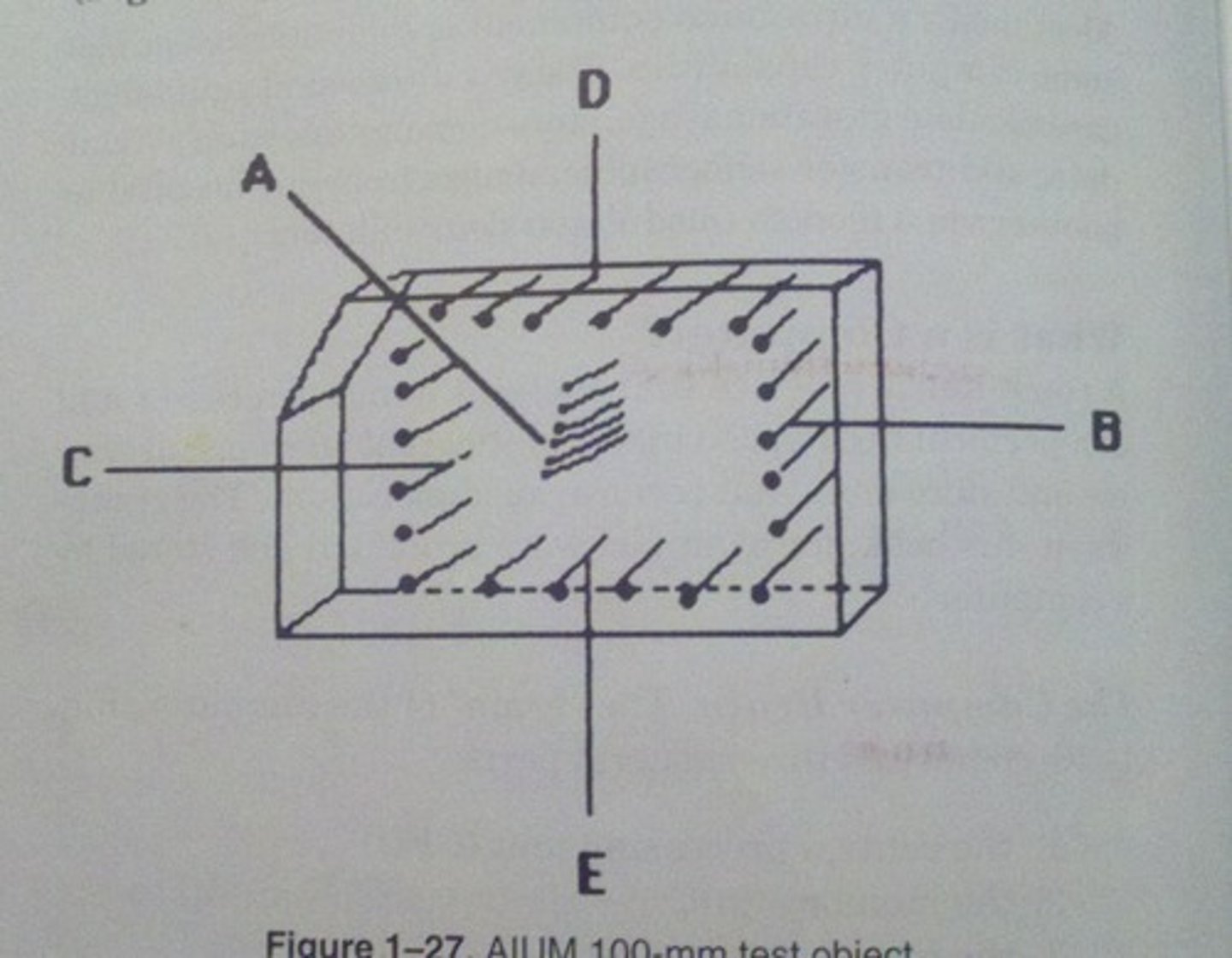
12. Axial resolution
Row A
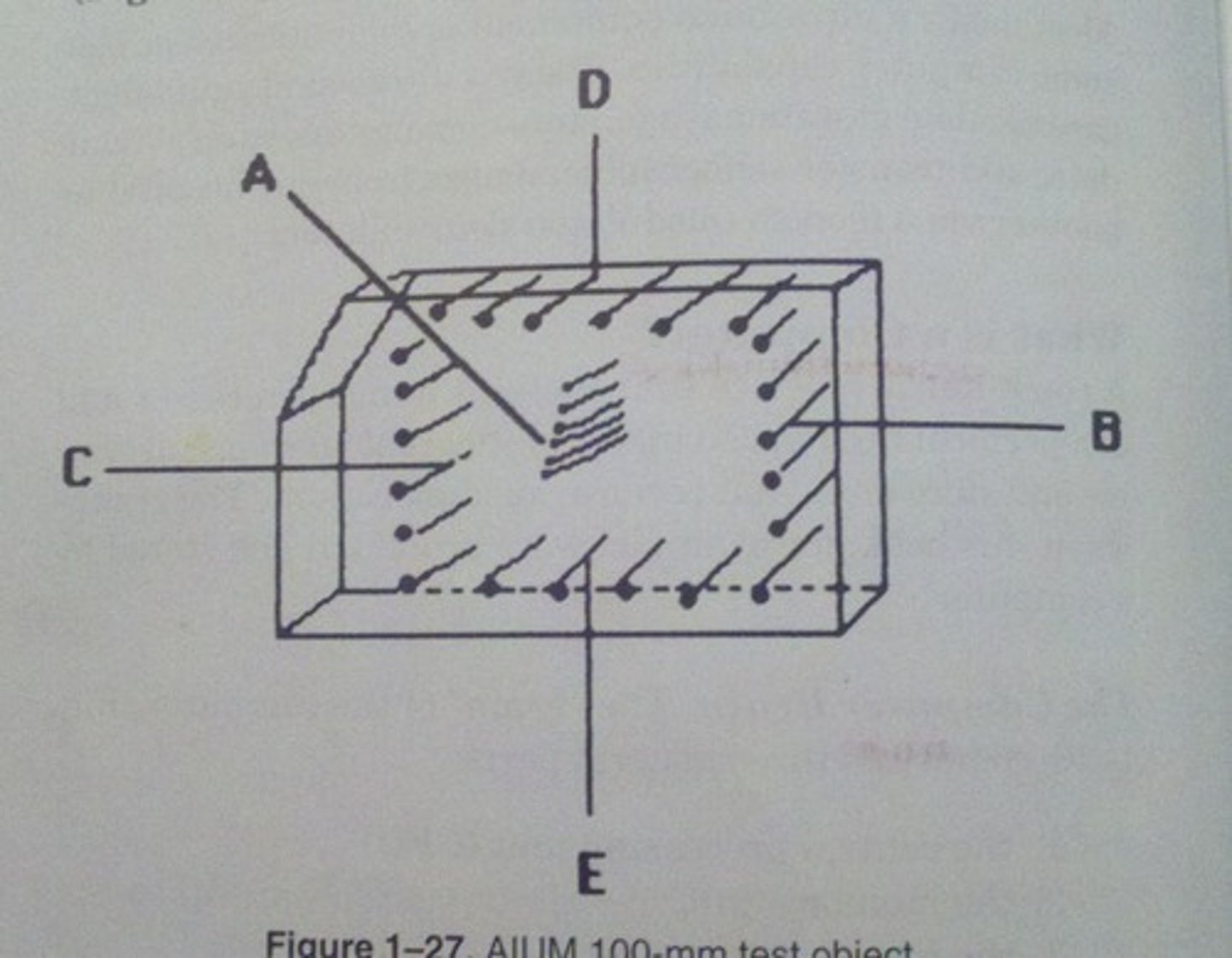
13. Lateral resolution
Row B

14. Dead zone
Row D
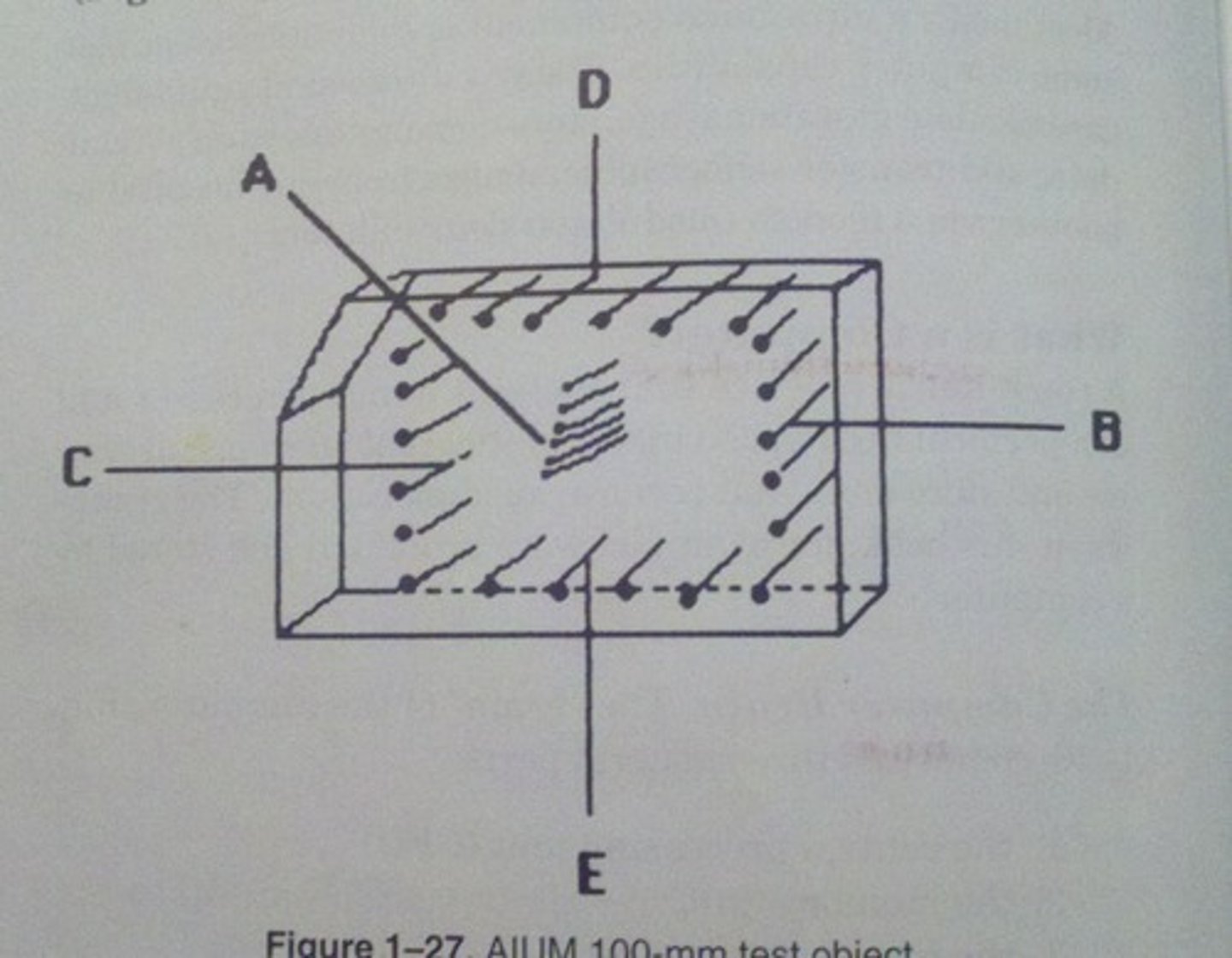
15. Depth calibration
Rows C or E
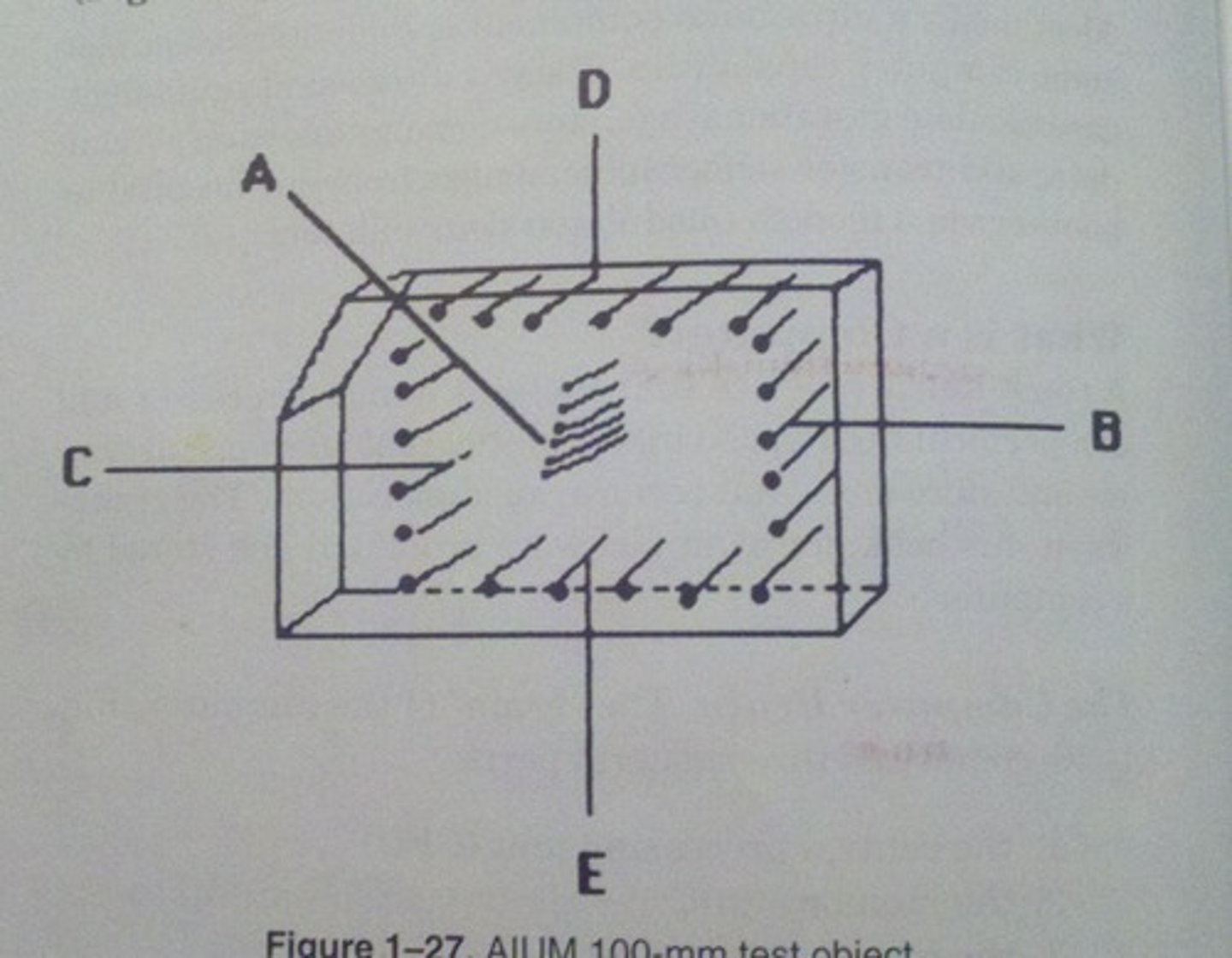
16. Decreasing the spatial pulse length
a) reduces the field of view
b) reduces the lateral resolution
c) improves axial resolution
d) improves lateral resolution
c) improves axial resolution
Decreasing the SPL improves the axial resolution. Axial resolution is equal to 1/2 of the SPL (LARRD=SPL/2)
17. How much will a 3.5 MHz pulse be attenuated after passing through 2cm of soft tissue?
a) 7 dB
b) 3.5 dB
c) 17 dB
d) 1.75 dB
b) 3.5 dB
A rule of thumb approximating the attenuation coefficient of a reflected echo in soft tissue is 0.5 dB/cm/MHz. This, the attenuation coefficient will be 1/2 of the operating frequency.
Attenuation= (A.C. dB/cm) x (path length cm)
dB= 1.75 dB/cm x 2cm= 3.5 dB
18. Propagation speed errors result in
a) reverberation
b) improper axial position
c) shadowing
d) a Doppler shift
b) improper axial position
Improper axial resolution (along the beam) position
19. Enhancement is caused by
a) strongly reflected structures
b) propagation speed errors
c) Snell's Law
d) weakly attenuating structures
d) weakly attenuating structures
ex) think of the bladder (attenuation rate is slower through fluid than SBT, so enhancement is seen posteriorly to bladder
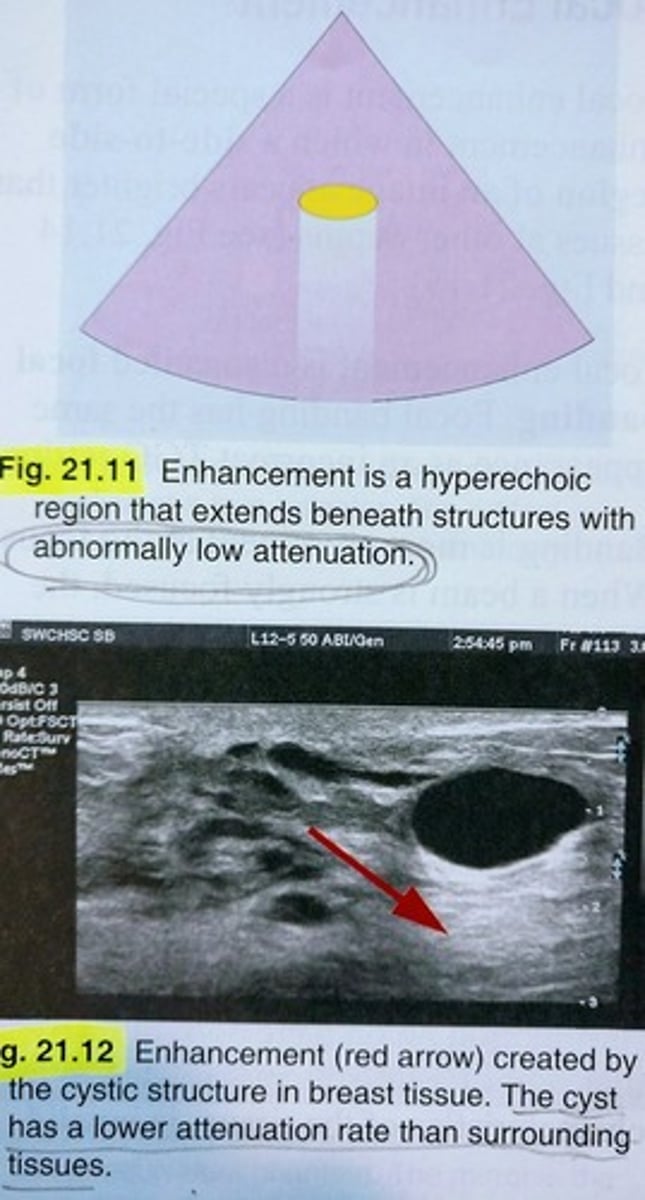
20. The Doppler shift frequency is
a) directly proportional to the velocity of the reflector
b) greater in pulsed Doppler systems
c) greater at high intensity levels
d) dependent on the number of transducer elements being used
a) directly proportional to the velocity of the reflector
the higher the velocity, the higher the shift (the higher the Nyquist limit)
21. The number of frames per second necessary for a real-time image to be flicker free is
a) more than 15
b) less than 10
c) between 6 and 10
d) between 3 and 6
a) more than 15
22. The SPTA intensity will always be larger than the SATA intensity
a) True
b) False
a) True
Spatial Peak (SP) values will always be greater than Spatial Average (SA) intensity values
23. The intensity of the ultrasound beam is usually greater at the focal zone because
a) decreased attenuation
b) the smaller beam diameter
c) diffraction effects
d) a shorter duty factor
b) the smaller beam diameter
intensity is defined as power per unit beam area; as the beam area decreases the intensity increases
24. If the amplitude is doubled, the intensity is
a) doubled
b) cut in half
c) increased by 4 times
d) unchanged
c) increased by 4 times
Intensity equals the square of the amplitude over the area
25. The attenuation for soft tissue is
a) increased with tissue thickness
b) determined by the scope of the TCG curve
c) increased with decreasing wavelength
d) unimportant when using digital scan converters
a) increased with tissue thickness
Attenuation is the product of the attenuation coefficient and the path length
26. The acoustic impedance of the matching layer
a) can be chosen to improve transmission into the body
b) must be much larger than the transducer to reduce attenuation
c) is not necessary with real-time scanners
d) must be made with the same material as the damping layer
a) Can be chosen to improve transmission into the body
Should be chosen to be at a value approximately equal to the mean of impedances of the material on the other side of it
27. In a pulse-echo system, the quality factor should be made as large as possible
a) True
b) False
b) False
The Q factor (quality factor) of a transducer refers to the length of time that the sound persists. High-Q transducers tend to ring for a long time, whereas low-Q transducers ring for a shorter time. A low Q produces a short pulse length, which is necessary to provide good images
28. The beam diameter is constant in the near zone
a) True
b) False
b) False
The beam diameter reduces to 1/2 of the transducer diameter from the face of the transducer to the focal point
29. The operating frequency
a) depends on the transducer's ring-down time
b) depends on the thickness of the crystal
c) is increased as the crystal diameter is decreased
d) depends on the strength of the pulser
b) depends on the thickness of the crystal
Thickness equals 1/2 the wavelength
30. The period of an ultrasound wave is
a) the time at whichit is no longer detectable
b) determined by the duty factor
c) the time of one wavelength
d) independent of the frequency
c) time of one wavelength
31. The dynamic range of a system
a) is increased when specular reflectors are scanned
b) is decreased when shadowing is present
c) can be increased through the use of coupling gel
d) is the ratio of smallest to largest power levels that the system can handle
d) is the ratio of smallest to largest power levels that the system can handle
The intensity of an ultrasonic beam can be measured with radiation force balance
a) True
b) False
a) True
Radiation pressure can be measured with a sensitive balance and converted to intensity
33. Increasing the pulse repetition period
a) improves resolution
b) increases the maximum depth that can be imaged
c) decreases the maximum depth that can be imaged
d) increases refraction
b) increases maximum depth that can be imaged
34. Ultrasound bioeffects
a) do not occur
b) do not occur with diagnostic instruments
c) are not confirmed below 100 mW/cm2 SPTA
d) are not confirmed below 1 W/cm2 SPTA
c) are not confirmed below mW/cm2 SPTA
35. No refraction can occur at an interface if the media impedances are equal
a) True
b) False
b) False
Refraction comes as a result of changes in sound velocity across a boundary, not impedance
36. Smaller transducers always produce smaller beam diameters
a) True
b) False
b) False
Beam diameter depends on whether of not the transducer is focused, the distance from the transducer, and whether one is in the near field or far field. Small transducers produce greatly diverging beams in the far field
37. The ultrasound beam profile can be measured with a hydrophone
a) True
b) False
a) True
A hydrophone is usually a very small piezoelectric crystal that can be moved in front of the transmitting crystal to map its beam characteristics
38. The pulsed-Doppler system yields better depth resolution than the continuous wave (CW) system.
a) True
b) False
a) True
Pulse Doppler utilizes range gating to localize the signals to specific depths
39. The gray-scale display was made possible when digital scan converters replaced analong scan converters
a) True
b) False
b) False
Gray-scale images were also possible with analog scan storage devices
40. Videotape recorders operating at 30 frames per second cannot be used with mechanical real-time units because the frame rate is too slow
a) True
b) False
b) False
If the imaging rate is slower than the video framing rate, frames are duplicated to fill in
41. Linear phased array scanners need no form of mechanical focusing because focusing is performed electronically
a) True
b) False
b) False
Linear arrays must also be focused in the direction perpendicular to the array axis to reduce the slice thickness. This is usually accomplished by mechanical focusing
42. The frame rate of real-time scanners depends on the number of lines used to form the image
a) True
b) False
a) True
Real-time scanners display 15-60 images per second, called the frame rate. This rate must be greater than 15 frames per second to produce flicker-free images. Each frame is made of scan lines per frame, and the number of frames per second are related to one another.
43. It is not possible to steer an annular phased array electronically
a) True
b) False
a) True
Annular phased arrays must be steered mechanically, most frequently through the use of an oscillating acoustic mirror.
44. The near zone length should be kept as short as possible
a) True
b) False
b) False
Images produced in the near zone have the best lateral resolution; therefore, the near zone length should be long enough to include all time regions-of-interest
45. What percentage of intensity of an ultrasound pulse incident on an interface of 0.25 and 0.75 rayls is reflected?
a) 50%
b) 100%
c) 24%
d) 75%
c) 25%
Reflection coefficient= {(Z2-Z1)/(Z2+Z1)} squared x 100
{(0.75-0.25)/(0.75+0.25)}^2 x 100= 25%

46. Axial resolution can be improved by using
a) higher frequency transducers
b) lower frequency transducers
c) larger transducers
d) poorly damped transducers
a) higher frequency transducers
Higher frequency transducers usually produce shorter spatial pulse lengths and thus improve axial resolution
47. When particle motion of a medium is parallel to the direction of a wave propagation, the wave being transmitted is called a
a) longitudinal wave
b) shear wave
c) surface wave
d) lamb wave
a) longitudinal wave
48. The wavelength in a material having a wave velocity of 1500 m/s employing a transducer frequency of 5MHz is
a) 0.3 mm
b) 0.3 cm
c) 0.6 mm
d) 0.6 cm
a) 0.3 mm
(1.5 mm/us)/ 5MHz = 0.3 mm
49. The factor that determines the amount of reflection at the interface of two dissimilar materials is
a) the index of refraction
b) the frequency of the ultrasonic wave
c) Young's modulus
d) difference in specific acoustic impedances
d) the difference in specific acoustic impedances
The fraction of sound reflected at an interface (r) is given by:
R= {(Z2-Z1)/(Z2+Z1)} squared x 100
50. The equation that describes the relationship among propagation, wavelength, and frequency is
a) C= frequency x wavelength
b) wavelength= 2(frequency x C)
c) Z= density x C
d) wavelength= frequency + C
a) C= frequency x wavelength
51. Which of the following can occur when an ultrasonic beam reaches the interface of two dissimilar materials?
a) reflection
b) refraction
c) mode conversion
d) all of the above
d) all of the above
Reflection refers to echoes; refraction refers to the bending of the beam; and mode conversion refers to a change in the propagation mode transverse, shar, surface, or longitudinal waves.
52. The acoustic impedance of a material is
a) directly proportional to density and inversely proportional to velocity
b) directly proportional to velocity and inversely proportional to density
c) inversely proportional to density and velocity
d) equal to the product of density and velocity
c) directly proportional to density and velocity
53. The average velocity of ultrasonic waves in soft biological tissue is
a) 1540 ft/s
b) 3300 m/s
c) 1540 m/s
d) 300 x 10^6 m/s
c) 1540 m/s
54. Receiver-angle values in CW Doppler analysis do NOT influence the final Doppler shift
a) True
b) False
b) False
The magnitude of the Doppler shift frequency is directly realted to the cosine of the angle between the direction of the blood flow and the receiver angle. The maximum shift frequency is, therefore, observed when the flow is along the receiver line of sight
55. Refraction occurs because of difference in ________ across an interface between two materials
a) acoustic impedance
b) wave velocity
c) density
d) none of the above
b) wave velocity
Refraction is described by Snell's Law, which relates that the incident angle to the transmitted angle, to the relative velocities of the two media making up the interface
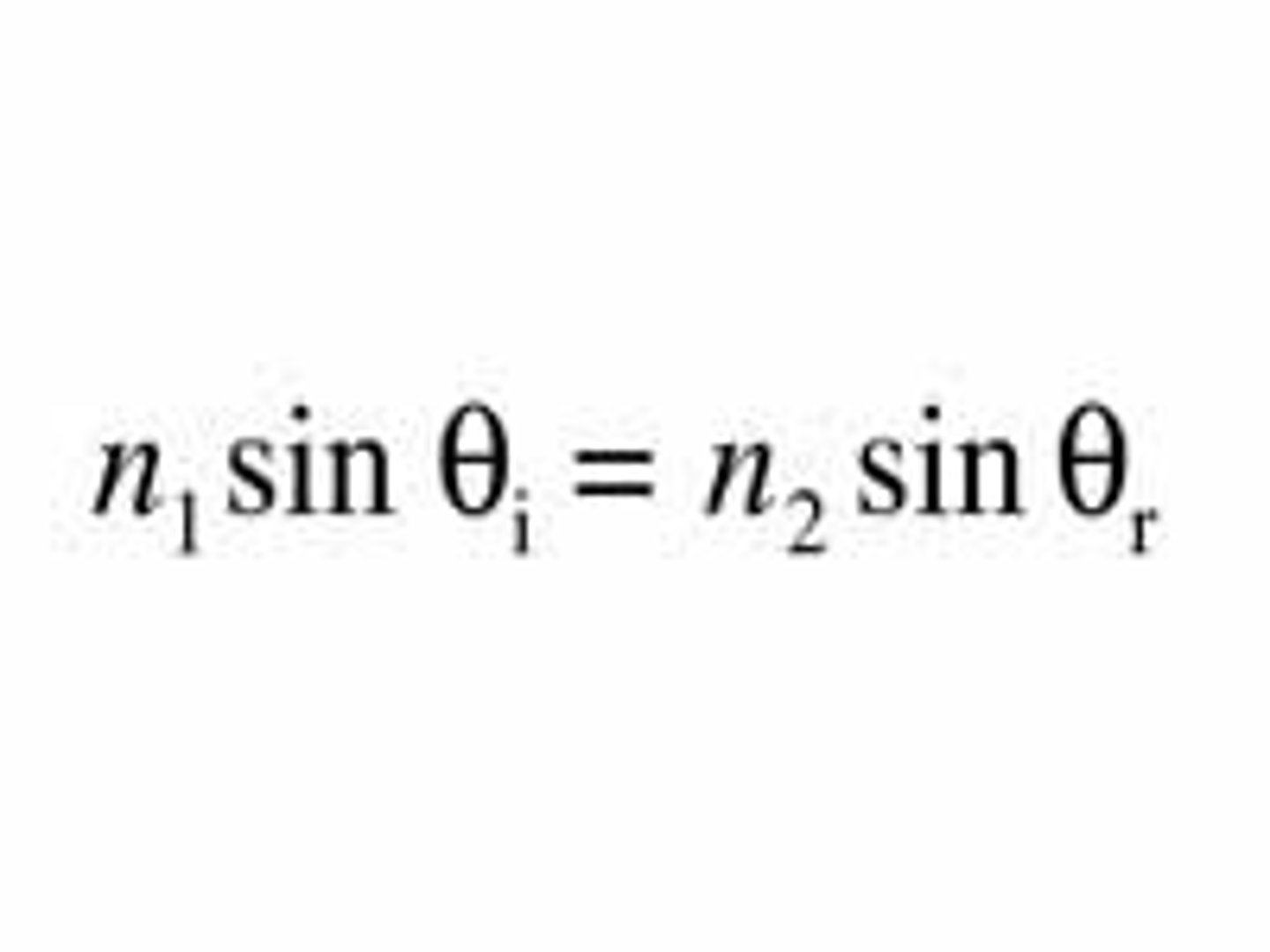
56. Reflection factor at an interface between two materials depends primarily on the change in ______ across the interface
a) acoustic impedance
b) wave velocity
c) density
d) none of the above
a) acoustic impedance
57. The velocity of sound waves is primarily dependent on
a) angulation
b) reflection
c) the material through which the sound is being transmitted and the mode of vibration
d) none of the above
c) the material through which the sound is being transmitted and the mode of vibration
58. Increasing the frequency of an ultrasonic longitudinal wave will result in _____ in the velocity of that wave
a) an increase
b) a decrease
c) no change
d) a reversal
c) no change
59. The change in direction of an ultrasonic beam, when it passes from one medium to another, in which elasticity and density differ from those of the first medium is called
a) refraction
b) rarefaction
c) angulation
d) reflection
a) refraction
60. A long near zone can be obtained by
a) using a higher frequency transducer
b) adding a convex lens to the transducer
c) decreasing the diameter of the transducer
d) increasing the damping
a) using a higher frequency transducer
NZL= (ap)^2/4 x wavelength
61. If a 2MHz frequency is used in human soft tissue, the wavelength is approximately
a) 0.75 mm
b) 0.15mm
c) 0.21 mm
d) 0.44mm
a) 0.75 mm
62. The ratio of particle pressure to particle velocity at a given point within the ultrasonic field is
a) interference
b) impedance
c) incidence
d) noise
b) impedance
Z= particle pressure/ particle velocity
Z= density x c
63. What is the following formula used to determine?
(2 x velocity of reflector x original frequency)/(velocity of sound)
a) shift in the frequency caused by the Doppler effect
b) degree in attenuation
c) distance a wave travels
d) amount of amplification necessary to produce diagnostic ultrasound
a) shift in frequency caused by the Doppler effect
Doppler shift equation
64. The principle that states that all points on a wavefront can be considered as point sources for the production of spherical secondary wavelets was postulated by
a) Doppler
b) Young
c) Huygens
d) Langevin
c) Huygens
65. A 10-dB difference in signal intensity is equivalent to a ______ difference
a) twofold
b) tenfold
c) hundredfold
d) thousandfold
b) tenfold
3 dB- 2x
6 dB- 4x
9 dB- 8x
10 dB- 10x
20 dB- 100x
66. The level below which signals are not transmitted through an ultrasound receiver system is the
a) intensity level
b) threshold, negative, or reject level
c) impedance level
d) dynamic range level
b) threshold, negative, or reject level
67. Gray-scale systems typically use ______ as a means of signal dynamic range reduction
a) rejection
b) compression
c) relaxation
d) elimination
b) compression
68. The strength of the echo is related to the height of deflection on the oscilloscope for the _______ display
a) A-mode
b) B-mode
c) B-scan
d) M-mode
a) A-mode
69. Which of the following is NOT a method for restricting the dynamic range of the signal?
a) suppression
b) rejection
c) compression
d) relaxation
d) relaxation
Relaxation processes are modes by which ultrasound may be attenuated in passing through a material. Suppression is another word for rejection
70. Most of the scan converters currently in use are of the ________ type.
a) analog
b) digital
c) bistable
d) static
b) digital
71. The fraction of time that pulsed ultrasound is actually on is the
a) duty factor
b) frame rate
c) cavitation
d) intensity transmission coefficient
a) duty factor
72. The ability of an imaging system to detect weak reflections is called
a) compression
b) demodulation
c) gain
d) sensitivity
d) sensitivity
73. Which of the following image shapes is produced by a linear sequenced array real-time transducer?
a) trapezoidal
b) rectangular
c) circular
d) diamond
b) rectangular
linear sequenced= rectangular
74. The major factor in determining the acoustic power output of the transducer is the
a) size of the transducer
b) magnitude of the voltage signals
c) amount of amplification at the receiver
d) amount of gain
b) magnitude of the voltage signals
magnitude of voltage spikes applied to the transducer by the pulser
75. Two primary mechanisms that produce tissue biological effects are
a) oscillations and radiation
b) absorption and reflection
c) direct and indirect
d) thermal and cavitational
d) thermal and cavitational
76. The _______ relates bandwidth to operating frequency
a) near zone
b) piezoelectric crystal
c) quality factor
d) far zone
c) quality factor (Q factor)
Q= operating frequency/ bandwidth
77. The extraneous beams of ultrasound generated from the edges of individual transducer elements and not in the direction of the main ultrasonic beam are called
a) phased array
b) impedance artifacts
c) side lobes
d) acoustic errors
c) side lobes
78. The product of the period and the number of cycles in the pulse is the
a) pulse repetition frequency
b) continuous wave
c) pulse repetition period
d) pulse duration
d) pulse duration
79. The substance typically used as a matrix on the imaging surface of an analog scan converter tube is
a) mercurous chloride
b) silicon oxide
c) manganese sulfide
d) lithium fluoride
b) silicon oxide
Silicon oxide matrix is charged by a scanning electron beam, producing an image pattern that can be displayed on a video monitor
80. Specular reflection occurs when
a) the frequency is small compared with the wavelength
b) the object that causes the reflection is small
c) the reflector surface is smooth as compared with the wavelength
d) the angle of incidence and the angle of reflection differ by at least 45 degrees
c) the reflector surface is smooth as compared with the wavelength
Reflectors whose boundaries are smooth relative to a wavelength behave as mirrors and are called specular reflectors